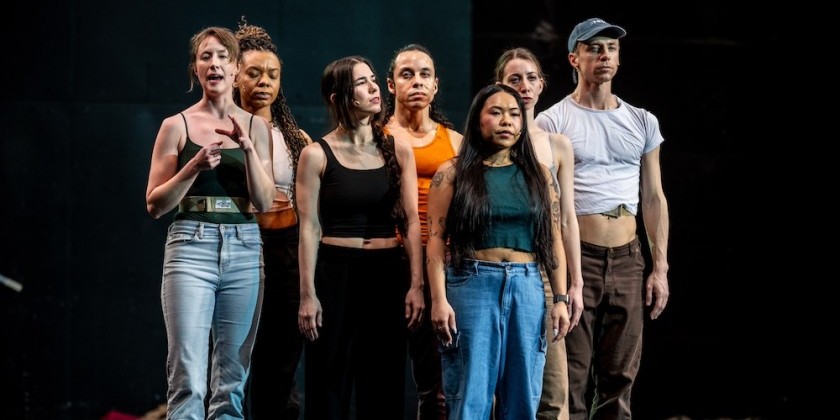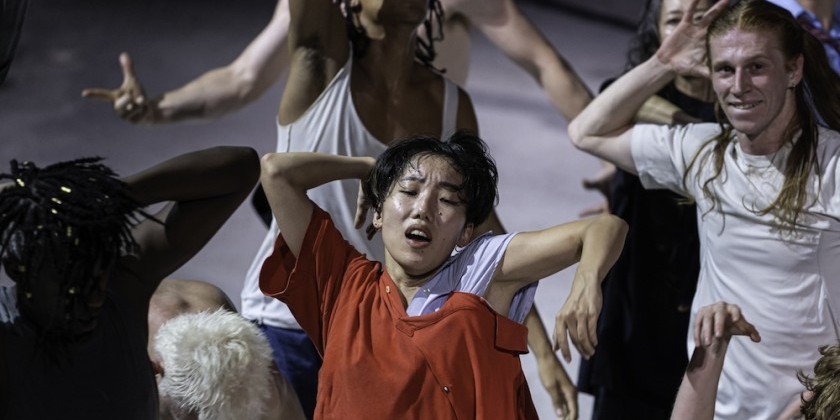IMPRESSIONS: Boris Charmatz’s “10000 Gestures” at NYU Skirball as part of FIAF’s Crossing the Line Festival

September 28, 2018
Choreography: Boris Charmatz
Choreographic Assistant: Magali Caillet-Gajan // Lighting: Yves Godin
Costume Design: Jean-Paul Lespagnard // Music: Wolfgang Amadeus Mozart
The math is simple if unbelievable. 60 minutes + 18 people = 10000 Gestures. The answer is also the title of the piece, and don't let the lack of a comma confuse you. That's ten thousand gestures, which no dancer will repeat, according to Boris Charmatz, the choreographer who dreamed up this formula. Receiving its New York premiere at NYU Skirball as part of FIAF’s Crossing the Line Festival, the framing device can be interrogated quantitatively and qualitatively.
First, the numbers. Does Charmatz succeed in his premise? The answer is probably, but it really doesn’t matter. 9,999 or 10,001 gestures wouldn’t make a difference. Neither would 5,617 or 13,824. It’s a glut regardless.

The more interesting question is: What constitutes a gesture? Merriam-Webster defines one as “a movement usually of the body or limbs that expresses and emphasizes an idea, sentiment, or attitude.”
Clearly, the dictionary has never been to a dance show. Or, in this instance, a non-dance show as Charmatz is one of the original provocateurs of a “movement” genre more akin to witty performance art.
For an hour, dancers rip through gestures that hopscotch from yogic bow poses to gazelle-like saut de chats, from twitchy fingers to wedgie picking. What idea, sentiment, or attitude they convey is irrelevant. These gestures exist as ticks in an ever-increasing balance sheet.

But how does Charmatz deconstruct this ceaseless cascade into discrete components? Does waving an arm front and then back count as one gesture or two? How about if a man in jeggings hinges backward while tracing a hand down his torso? When the cast gathers into a clump and writhes, how many or how few gestures is that? Can loud vocalizing count? It should because there’s a lot of it.
Maybe one plus one equals two or maybe it equals one, yet the purest expression of a gesture isn’t found in the movement. It’s in the peripheral elements. Mozart’s Requiem in D minor K.626, a dramatic mass for the dead, serves as a punch line for Charmatz’s “anti-museum” work, which has been designed to resist preservation and replication. The outfits slide on a spectrum from costumes (a bespangled majorette getup) to clothing (swirly summer dresses), ending with near nudity (jock straps). In their specificity and clarity, song and garb satisfy the emotive and expressive potential of a gesture.

The most memorable actions aren’t the ones that unfold onstage. Close to when the choreographic thunderstorm — Noise! Light! Commotion! — saturates my interest, the performers enter the audience. They clamber over us, they shake our hands, and they rip up our programs. The reactions of flinching, laughing, and extending a helping hand add more gestures to the balance sheet.
Near the end of the audience assault, one of the female performers (perhaps Salka Ardal Rosengren) strokes my hair. She whispers, “You have beautiful hair ” as I squirm, my contribution to the five-digit goal complete.
Maybe the formula needs to be rethought. 10,000 gestures – 9,999 = the only one that counts.
The Dance Enthusiast Shares IMPRESSIONS/ our brand of review and Creates Conversation.
For more IMPRESSIONS, click here.
Share your #AudienceReview of performances for a chance to win a prize.















